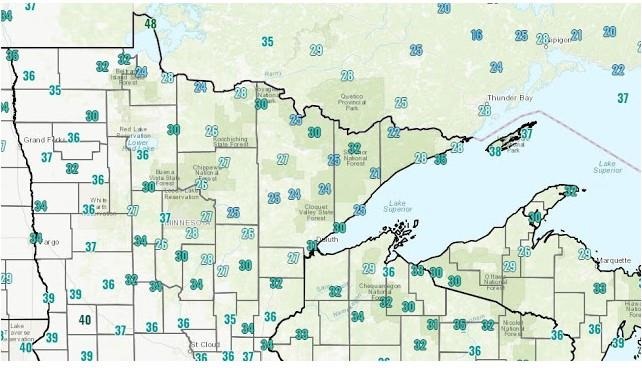By Jeff Coulter
Assessing freeze injury
Air temperatures dropped below freezing during the early morning hours on May 28 in portions of the northern half of Minnesota, resulting in freeze injury to corn in some fields. Most of the damaged corn was at the two to three leaf collar (V2 to V3) stages. Symptoms of freeze injury to corn initially appear as discolored water-soaked leaves, which later dry and turn brown. The growing point on young corn plants at the V2 to V3 stages is about 0.75 inches below the soil surface, and it will remain below the soil until the five leaf collar (V5) stage. Therefore, freezing air temperatures prior to the V5 stage typically do not kill corn unless prolonged cold temperatures freeze the upper part of the soil where the growing point is located.
 |
| Temperatures across the northern half of Minnesota at 4am on May 28, 2021 (Image credit: NWS Twin Cities). |
Corn recovery is greatest when freezing occurs before the V3 stage or when only a limited amount of leaf area is damaged at or beyond the V3 stage. Freeze-damaged corn generally shows new leaf growth a few days after experiencing freezing temperatures if the growing point was not damaged. Therefore, assessment of damaged fields should be delayed until at least three days after the freeze injury occurred. Corn plants that are recovering from freeze injury can resemble buggy whips as new vegetative growth tries to break free of dead tissue, as in the above photo. Such plants generally recover, with a faster recovery rate for smaller plants and when warm and windy conditions occur after a freeze. However, for some larger plants that are severely freeze-damaged, it can be difficult for the new growth to break free of dead tissue. Such plants may take substantially longer to recover, and some may never fully recover.
If freeze-damaged corn is assessed before new leaf growth is visible, one can determine whether freeze-damaged corn will survive by digging up plants and splitting the stems to examine the growing point and the tissue directly above the growing point. Healthy growing points will be firm and white to yellow. If the growing point or tissue within 0.5 inches above the growing point is damaged, it will be water soaked and orange to brown, and recovery will be unlikely.
Yield reductions due to freeze injury
Yield loss in corn due to early-season freeze damage is influenced by the severity of damage and the proportion of plants that recover in a timely manner. Research from Wisconsin found that grain yield was reduced by 8% when all corn plants were cut off at the soil surface at the V2 stage, but that yield was not significantly reduced when only half of the plants were cut off (Lauer, 2007). This provides a starting point for predicting yield loss. However, recovery of freeze-damaged plants may be slower than that of plants that are cleanly cut off at the soil surface, because the new vegetative growth needs to break free of dead tissue. Therefore, yield loss due to freeze damage at V2 could be somewhat greater than that in the Wisconsin study.
Yield loss due to freeze injury is also affected by a reduction in plant population. Plants that are severely damaged and very slow to recover may produce little or no grain. Although the proportion of plants that are like this is expected to be low, this will likely contribute to a reduction in overall yield in the field. In Minnesota, reductions in corn grain yield of around 5 and 12% are expected when the plant population is reduced to 28,000 and 22,000 plants per acre, respectively. Early-season freeze injury also tends to delay corn maturity by a few days in the fall.Replanting considerations
In most cases, replanting will not be necessary for corn that was damaged by a freeze when it was at the V2 to V3 stage or younger. Before replanting, consider the yield potential of the existing crop, replanting costs, and the yield potential of a replanted crop. If harvesting corn for grain in central and northern Minnesota, corn replanting should be completed by June 5 to avoid high risk of corn freezing in the fall before it reaches maturity. If replanting, choose hybrids of appropriate maturity (Table 1).
Table 1. Corn hybrid relative maturity (RM) guidelines for late planting in Minnesota.| Planting date | Hybrid RM guidelines |
|---|
| May 22 to May 28 | Plant hybrids that are 5 to 7 RM units earlier than full season |
| May 29 to June 4 | Plant hybrids that are 8 to 15 RM units earlier than full season |
| June 5 or later | Plant hybrids that are 15 or more RM units earlier than full season |
In field trials in Minnesota, maximum grain yield occurred when corn was planted in late April to early May. In comparison, corn planted on May 30 yielded 82 to 89% of the maximum, corn planted on June 4 yielded 76 to 84% of the maximum, and corn planted on June 9 yielded 69 to 79% of the maximum.